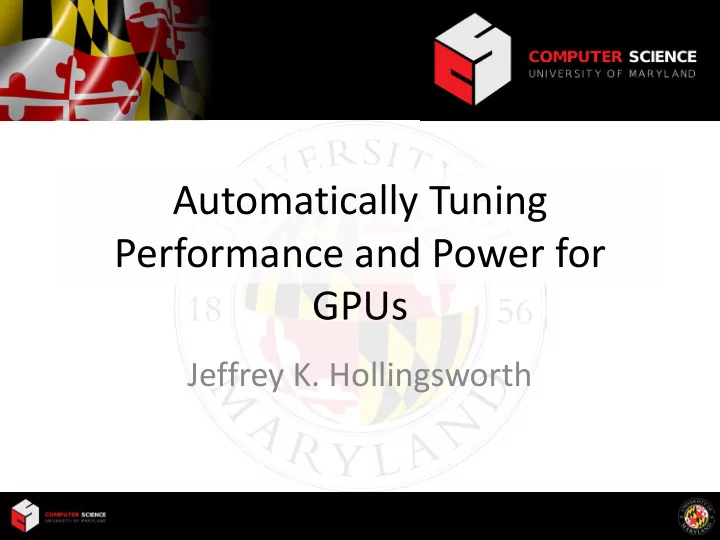

Automatically Tuning Performance and Power for GPUs Jeffrey K. Hollingsworth
What is Auto-tuning? Making programs “better” based on empirical feedback from observed runs without programmers having to in the loop. What to Tune Parameters: Application, library, OS, … Code: re-compile the program Algorithms Node or multi-node performance When to Tune Once per architecture/machine/application Once per data set Once per run of the program Continuously during program execution
Why Auto-tuning? • Example, a dense matrix multiple kernel • Various Options: – Original program: 30.1 sec – Hand Tuned (by developer): 11.4 sec – Auto-tuned of hand-tuned: 15.9 sec – Auto-tuned original program: 8.5 sec • What Happened? – Frustration for the person trying to auto-tune! – Hand tuning prevented analysis • Auto-tuned transformations were then not possible
Impact of Compiler Options
Active Harmony Approach to Automated Performance Tuning • Goal: Improve performance without training runs • Problems: – Large number of parameters to tune – Shape of objective function unknown – Multiple libraries and coupled applications – Analytical model may not be available • Requirements: – Runtime tuning for long running programs – Don ’ t try too many configurations – Avoid gradients
Auto-Tuning Objectives • Single Objective – “More money is better.” – The best solution is easy to select • Multi-Objective – “Is more money or more free-time better?” – Multiple different, but equally good solutions – The best solution becomes a subjective choice
Multi-Objective Example • Minimize both energy and runtime • Pareto set formed by non-dominated solutions – Solutions cannot be strictly improved upon
Existing Approaches • Use experiments to find entire Pareto set – Algorithms judged by accuracy and efficiency – Evolutionary algorithms are widely used • Provide set to users for final selection – This step is unacceptable for auto-tuning
Introducing NEMO • Non-Evolutionary Multi-Objective Search Algorithm • Goal: – Return a single solution, not a set of solutions • Inputs: – Objective preference ranking • “When in conflict, I prefer runtime to be optimized over power.” – Objective leeway percentage • “The search may stray up to 20% from the best known runtime.”
NEMO Algorithm • Consider the first objective in isolation – Search using single objective search algorithm – Nelder Mead used in our experiments • Record a threshold for first objective using leeway – Penalize any future searches that exceed threshold • Repeat for objectives 2 through N – Search “landscape” changes with each iteration – Final landscape affected by all prior thresholds • Single objective search led to proper multi-objective solution
Comparison of Search Techniques Function Search Quality Search Efficiency Evaluations Rand ParEGO NEMO Rand ParEGO NEMO kno1 62 2.385 2.950 2.081 11.665 7.711 6.800 oka1 53 1.605 2.783 0.833 4.294 5.124 2.444 oka2 59 2.294 2.978 2.068 5.903 5.891 3.391 vlmop2 56 0.119 0.055 0.377 0.627 0.637 0.326 vlmop3 87 1.172 1.371 1.231 7.808 4.567 2.378 dtlz1a 141 67.889 3.368 0.840 220.07 118.498 30.346 dtlz2a 209 0.893 0.935 0.665 0.963 0.925 0.651 dtlz4a 241 1.080 0.678 1.415 1.792 1.499 1.451 dtlz7a 223 12.992 8.351 6.327 12.721 9.135 11.646
GPU Tuning
Conclusions • Programmers don’t want to tune programs – Lets computers do that • Auto-tuning is ready to meet this need • Need to efficiently support multi-objective search – At least 2 objectives, likely more – NEMO is a promising option for this
Recommend
More recommend